A Private Tour today in North Norfolk. It was a mostly bright and sunny day with patchy high cloud, until later in the day when a band of rain spread in, thankfully just as we were finishing up. We had a particular target list of species for the day, which saw us working the coast from end to end.
We met in Salthouse and headed inland, up to the heath to start. We really wanted to see Dartford Warbler, but with the population here seemingly struggling this year, we knew it would be difficult. As we arrived in the car park, we could hear Chiffchaff and Willow Warbler singing. Walking up along the path, several Linnets flew round over the gorse and we heard a Yellowhammer singing. There has been a Woodlark feeding in the area here, but there was no sign of it as we passed.
There were lots of butterflies out this morning. There are still plenty of Painted Ladys around, following the invasion in recent days, although some of them are starting to look a bit battered now. The Silver-studded Blues have been slow to emerge this year, but are now out in increasing numbers. We also flushed several July Belle moths from the vegetation by the paths too, today.

We thought we would try our luck again and see if the Nightjar we had found the other day was roosting back on the same perch today, but unsurprisingly there was no sign of it. However, as we walked back round to the main path, we accidentally flushed another Nightjar from its roosting site hidden down in the bracken. It was a male, we could see its white wing flashes and corners to its tail as it flew up and disappeared into the trees.
Continuing on round the heath, we found several Stonechats, but no Dartford Warblers. An alarm calling family of Common Whitethroats was the closest we got. An Adder, basking on the path, slithered off into the heather as we approached. We flushed a pair of Yellowhammers collecting food in the gorse and bracken.
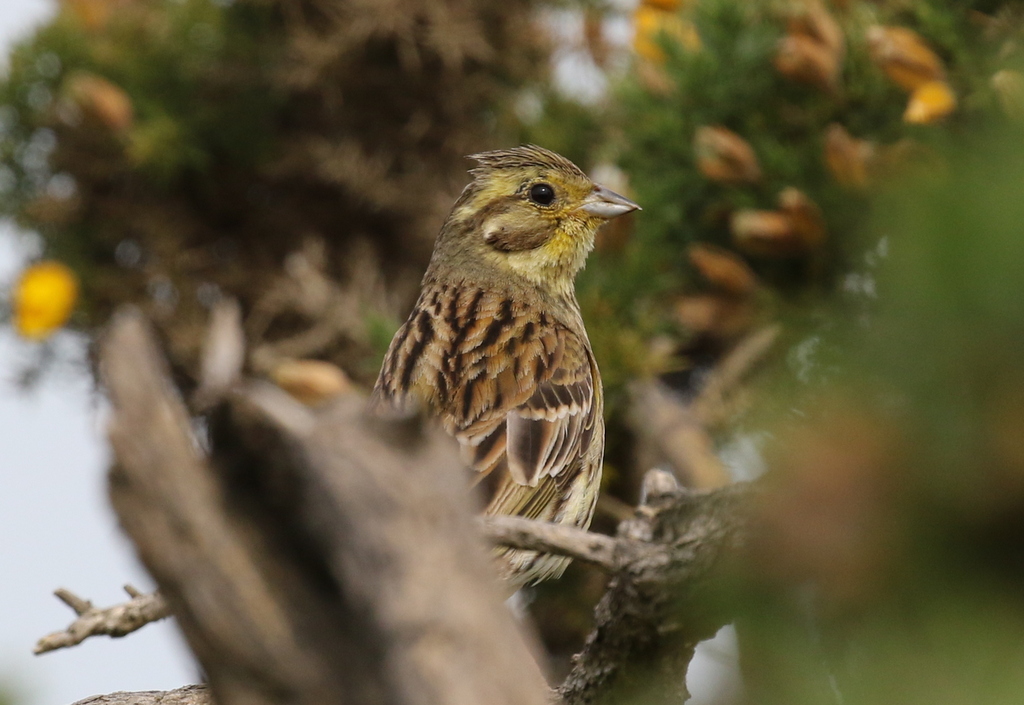
A Woodlark was reported singing earlier from back up where we had looked by the car park on our way out, so we decided to have a look for that instead. A Garden Warbler was singing from the birches on our way back, but despite walking all round the area where the Woodlark had been, there was no sign of it now. We decided to cut our losses and try something else.
Firecrest was the nest species on the list, so we headed over to Holt Country Park. We were not sure whether the Firecrests would be singing now, but as we were trying to pay for a parking ticket at the faulty pay & display ticket machine, we heard one singing from the trees behind us. Once we had gathered in the car park to listen, it had gone quiet, but thankfully then started up again closer to the road after a few minutes. We followed the sound and had some good views of it flitting around in the ivy-covered trees. We could see its bold white supercilium. A Goldcrest was singing nearby too.

We were back on track now, and with our target here achieved so quickly, we had time to sit down and get a coffee at the cafe. A Siskin flew over calling while we were enjoying the morning sunshine.
From Holt, we had a long drive all the way over to the opposite end of the coast to look for Turtle Doves. We parked on the beach road at Holme and walked along the track towards the Firs. Two Stock Doves, three Collared Doves and a couple of Woodpigeons were all perched together in a small group of sallows in one of the gardens, but there was no sign of their rarer cousin. We could hear a Cuckoo calling, and turned to see it fly across the meadows the other side of the road. A Sparrowhawk circled up in the distance, along with a couple of Marsh Harriers.
A Cetti’s Warbler was singing further along. This was also on the target list for today, but it is a species which is rarely seen, and generally just heard. We walked down a narrow path along by the river, heading towards where we had heard the Cetti’s Warbler singing. A Sedge Warbler and a Chiffchaff were feeding in the vegetation down in the water.
The Cetti’s Warbler sang again, further up along the path, so we walked on. As we came out from under some trees, it suddenly appeared out of a bed of nettles right by the path, flying up into the low branches of an overhanging willow. We had just a brief view, before it dropped back down into the bushes by the river, and then flew round behind us, but it was more than we had hoped for. As we walked back along the path, the Cetti’s Warbler shouted at us from some bushes ahead, but it had returned to being more typically elusive and we didn’t see it again.
Past the last house, we walked round and up onto the coast path. A flock of Starlings whirled round out over the saltmarsh. We took the coast path back west to the old paddocks, where a Common Whitethroat was singing from the hawthorns. We had just stopped to listen to a Lesser Whitethroat further along when two Turtle Doves flew out of the trees and over the path ahead of us. We followed them out over the saltmarsh, and watched as they dropped down over the dunes towards the beach.
We decided to walk round to the beach to see if we could get another look. We had to take a bit of a long diversion round the cordon on the beach erected for nesting birds. An Oystercatcher walked off over the stones as we passed and a Ringed Plover was feeding down in the bottom of a sandy creek. A Little Tern flew up calling and circled round overhead.
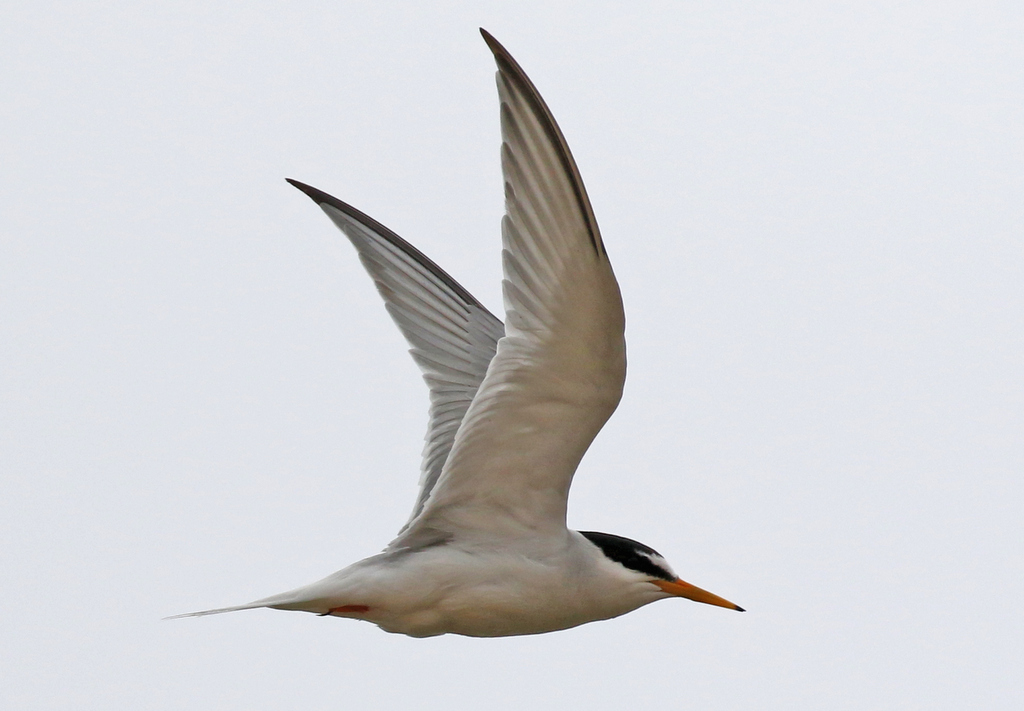
As we rounded the far end of the cordon, the two Turtle Doves flew up from the dunes ahead of us. They circled round and dropped down again further over, in the middle of the fenced off area. The path through the dunes on the inland side of the cordon took us past that area, but the grass in the middle was very long and we couldn’t see any sign of them, so we climbed up onto the dune ridge to scan distantly from a higher vantage point.
One of the Turtle Doves flew up again, circled round, and dropped back down into the long grass. Then two Turtle Doves came up and circled round together. When they dropped down again, three came up the next time. This time they flew over towards the saltmarsh, the pair coming straight past us before heading back over to the paddocks. We had much better flight views this time – we could see the rusty scaling on their backs – worth the walk out here.
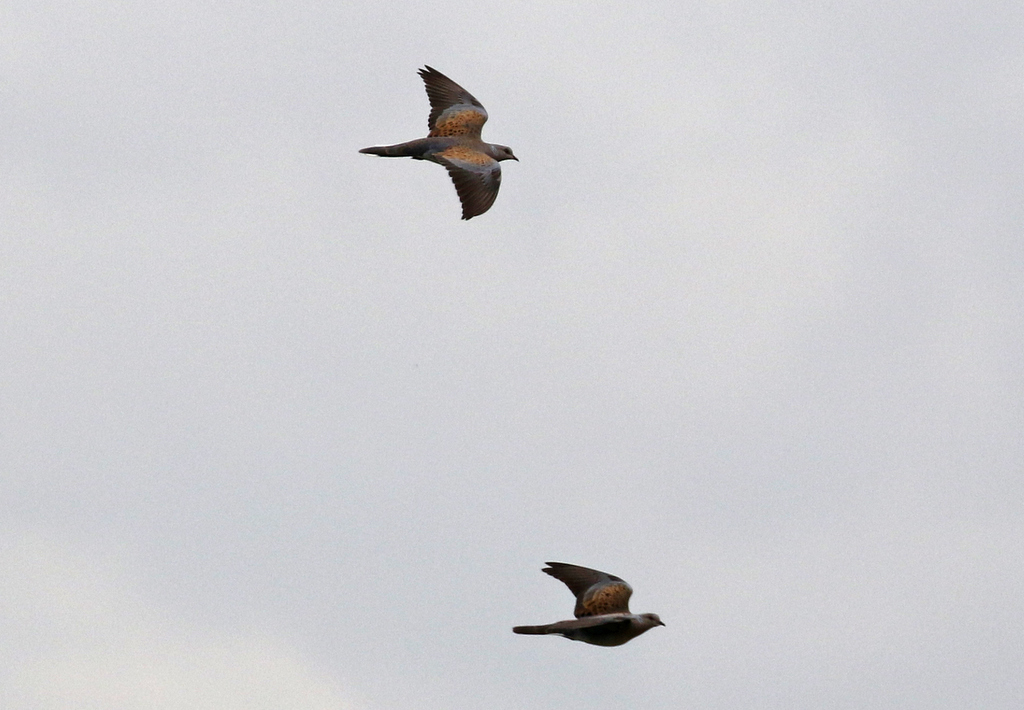
We walked back along the path towards the golf course. A Common Blue butterfly fluttered up from the dunes as we passed. Several Stock Doves came out of the grass, suggesting there must be lots of food out here for them at the moment. Then we crossed back to where we had left the minibus and had lunch on one of the picnic benches by the entrance to the car park.
Our next destination was Titchwell. Calling in at the Visitor Centre, we were told that a Hobby was hunting from the dead trees at the back of the reedbed, another species on our list. We walked straight round to Patsy’s Reedbed and had good views of the Hobby through the scope from there, perched in the trees. It kept flying off, making sorties to hunt, but returned each time to a different perch.
Several Red-crested Pochards were feeding out on the water in front of the screen, one of the easier target birds to tick off the list. Three drakes were just starting to moult, variously starting to get some browner feathers in their upperparts, but the fourth male was already in eclipse, looking rather like a female but with a bright coral-red bill. There were also a few Common Pochard and Tufted Ducks, and a Little Grebe on the water here this afternoon.
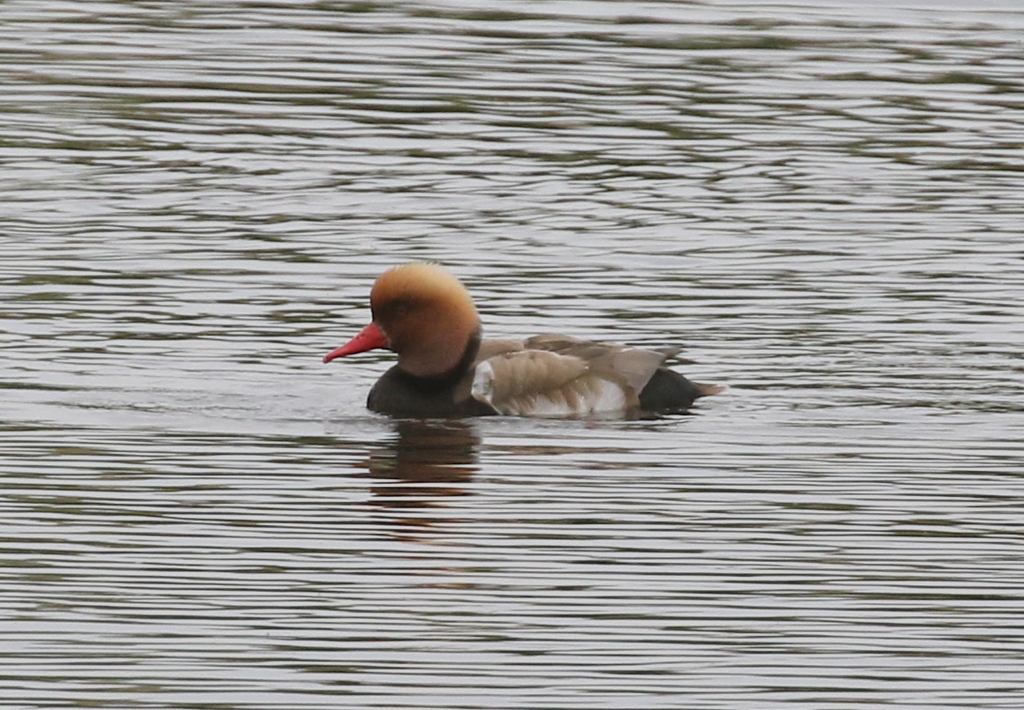
There were several Mediterranean Gulls in with the Black-headed Gulls bathing out in the water. Once you got your eye in, they were easy to pick out with their black hoods and white wing tips. We knew we could get better views out on the Freshmarsh though. There were several Bearded Tits in the reeds here, but they kept dropping down out of view. There was no sign of the Purple Heron in the short time we were there, but we didn’t want to waste hours waiting for it to reappear.
Out along Meadow Trail, a couple of Reed Warblers were flitting round the edge of the dragonfly pool, and one flew up to sing in the trees by the path. Along the main path by the reedbed, there were several Reed Buntings singing and Sedge Warblers flying in and out of the reeds by the small pools in front. We could hear more Bearded Tits calling and they were a bit easier to get onto here, flying back and forth across the channel through the reeds and across the front of the main reedbed pool, if a little more distant.
We stopped it at Island Hide. Several Avocets were feeding on the mud and shallow water in front of the hide, along with a few Black-tailed Godwits. There were quite a few Common Redshanks on here today, but we couldn’t see any Spotted Redshanks from where we were. A distant Little Ringed Plover was on one of the islands over by Parrinder Hide.
There are noticeably more Teal on the Freshmarsh now, with birds starting to return already from their breeding grounds further north. The local Mallard, Gadwall and Shoveler are looking a bit tatty, moulting into eclipse plumage now.
From round at Parrinder Hide, we found the Spotted Redshanks, right over at the back against the reeds today. There were six in total, all still largely in their very smart sooty black breeding plumage, very different from the grey-brown Common Redshanks. As expected, there were plenty of Mediterranean Gulls here too, with a good number of them now loafing on the islands in front of the hide. There were lots of 2nd summers in with them today, looking like summer adults with their black hoods but still with black in their wingtips. The fenced off ‘Avocet Island’ is still chock full of noisy nesting gulls.
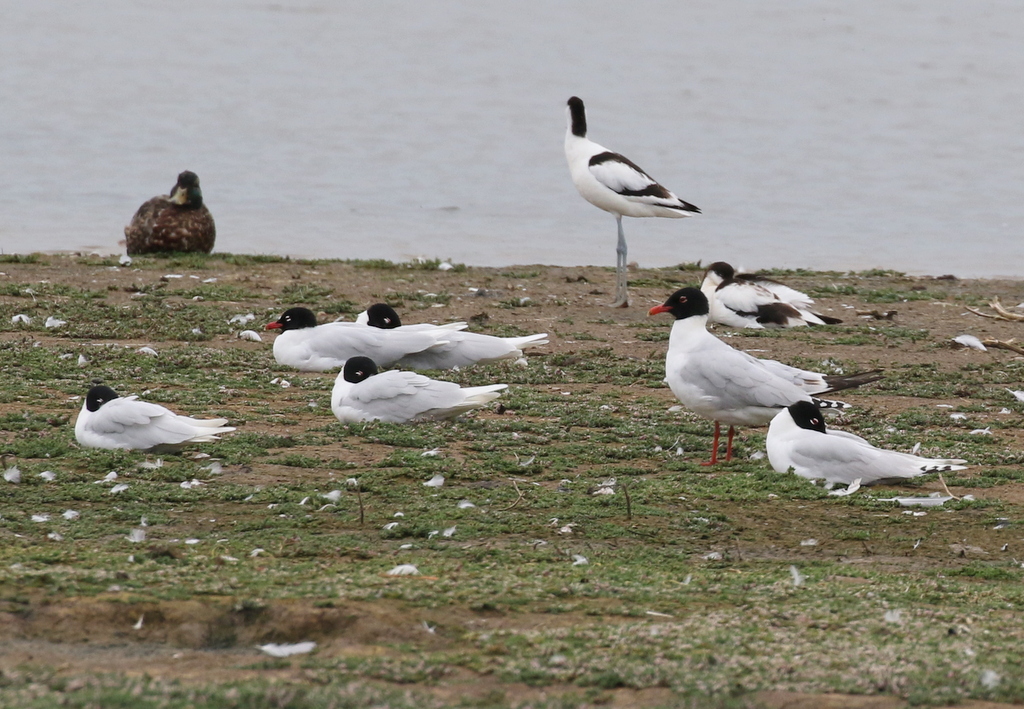
A couple of Little Ringed Plovers flew round calling, right below the front of the hide. We watched one land on one of the islands and run quickly over to a shallow depression in the ground. It seemed to be scrape building, as it looked to work at the ground with its legs and then pick round the edge as if tidying up. When another Little Ringed Plover approached, the two of them walked in parallel across the island, stopping and bobbing they heads, or picking at the ground.
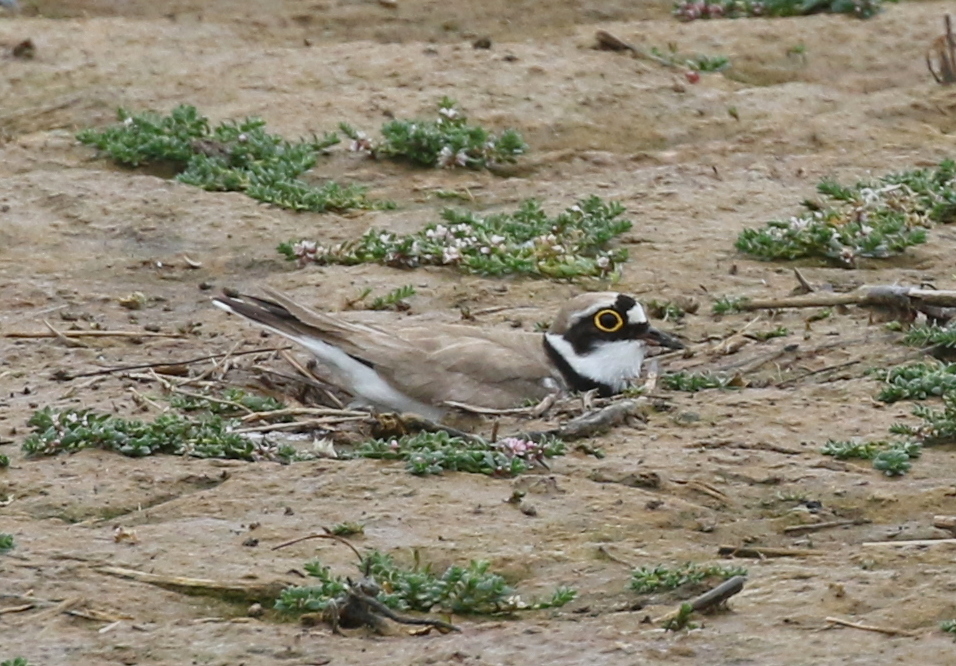
It was time to head back, as we had one last stop we wanted to make as we returned east along the coast. We could see darker cloud building from the west and it started to spit with rain as we walked along the bank towards the Visitor Centre.
Our final destination for the afternoon was at Wells. We could see several Spoonbills on the pools without even getting out of the minibus. We did get out and walked down along the track for a closer look. There were several adults busy feeding in the water, and two juveniles still with only partly grown bills over on the far bank. Two of the adults were feeding together, almost synchronised, walking side by side and sweeping their bills through the water in unison. We could see the mustard wash on their breasts and their shaggy nuchal crests and, when they caught something and lifted their heads, we could see the yellow tips to their black bills.
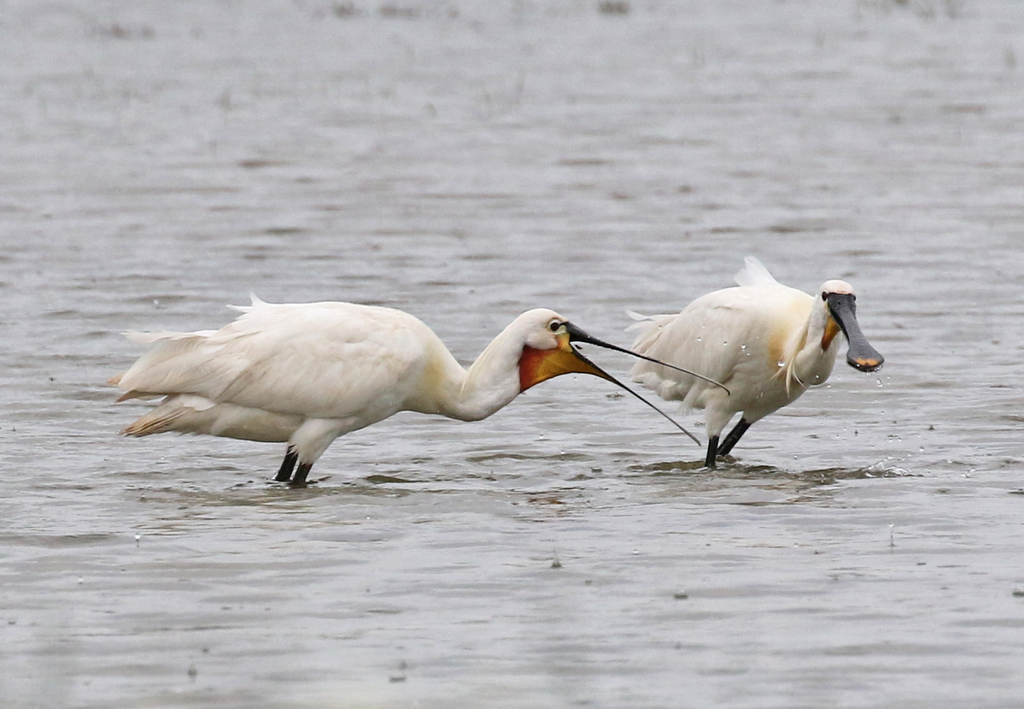
Egyptian Geese was another one on the list and another nice easy one here. There were seven together, loafing in the grass close to the track. It had been spitting lightly with rain but at this point it started to fall more heavily. We decided it was time to call it a day and head for home. We still had a couple more birds to add to the list on the way – a Grey Heron out on the marshes at Cley, and a Barn Owl hunting the grazing marshes by the road as we drove back in to Salthouse to round things off nicely.
















